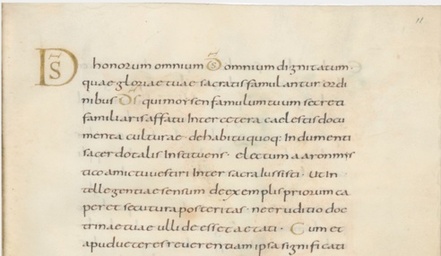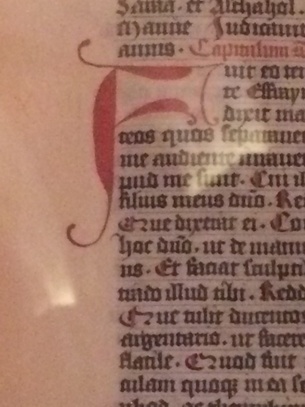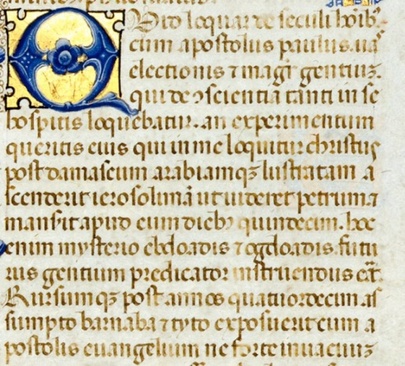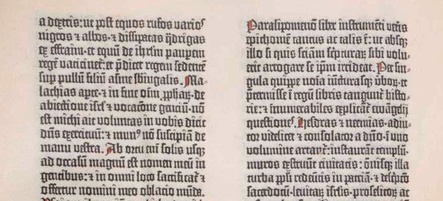. The Bible Through the Ages .
|
|
CELTIC (600-900)Celtic manuscripts based on the Old Latin and Jerome’s Latin translation with old English interlinear summaries in Britain's pre Roman Catholic Christianity. These were Gospel books and books of Psalms produced by Irish monks. Examples include the Book of Kells, the Lindisfarne Gospels, and the Book of Darrow among others. Features include zoomorphic figures struggling. Script for the text is referred to as insular. The Viking raids on the monastery on the Isle of Lindisfarne in Northumbria in 793 are recorded in the Anglo Saxon Chronicles. The Vikings came for the gold and silver artifacts and therefore did not plunder the Gospel Book at Lindisfarne, which is now in the British Museum in London. BBC broadcast on early medieval church history is here. Also, read Thomas Cahill’s How the Irish Saved Civilization for insights on the period.
See a multi part documentary about the Book of Kells, which was produced off the coast of Scotland on the Isle of Iona circa 800 in a monastery established by St. Columba in 563. Read more about Christianity in Britain here. |
VISIGOTHIC (418-720)The Visigoths ruled the Iberian peninsula and had embraced Arian Christianity. With the Islamic Arab conquest of Iberia by the Umayyads in 711, a series of apocalyptic manuscripts were produced in a monastery in the mountains of northern Spain that focused on the end of the age. Known as the Beatus, the commentaries on Daniel and the Apocalypse feature the Visigothic minuscule script.
|
CAROLONGIAN (751-987)Charlemagne, or Charles the Great, became king of the Franks in 768, king of Italy in 774, and in 800 became the first Holy Roman Emperor. Like his forefathers, Charlemagne stayed off Muslim incursions into Europe. He is credited with the desire to spread learning and revive Roman administration and style in architecture. Carolingian refers to the family line of Charlemagne, the father of Europe. Charlemagne retained Alcuin of York, an Anglo Saxon, to direct a school and scriptorium at the palace in Aachen. Other centers of learning and writing later included Reims, Salzburg, Mainz, and Bobbio. Carolingian manuscript text is referred to as Carolingian Minuscule. The opening display letters are in gold and the main script is referred to as Caroline minuscule.
|
OTTONIAN (919-1024)Ottonian refers to the Germanic Saxon line of rulers between Henry I and Henry II, but named after the second ruler Otto I. Manuscript production appears to have taken place on Reichenau Island in Lake Constance in southern Germany. Read more about the Ottonian period here.
|
ROMANESQUE (1100-1200)While the Romanesque period can be broadly defined as the four hundred years between 800 and 1200, there were regional variations based upon the political control over geographical regions of Europe. The later Romanesque period should rightfully be referred to as Anglo-Norman, because the manuscript work that took place on both sides of the English Channel after the Norman invasion of William the Conquerer is distinct from the earlier Carolingian and Ottonian styles. Examples of the Anglo Norman Romanesque style include the Winchester Bible, the Lambeth - Maidstone Bibles, the Bury Bible, the Dover Bible, the Parc Abbey Bible, and the Capucin Bible. Features include illuminated historiated book opening letters. Bold display script. Script for the text is Carolingian-Romanesque. See video Great Illuminated Bibles of 12th-Century England. The frescoes in the Church of the Holy Virgin in Asinou, Cyprus is aesthetically connected with the art of Master Hugh of the Bury Bible (c. 1130). See video.
See VIDEO filmed at the Metropolitan Museum of Art when one of the volumes of the Winchester Bible was on loan and exhibited. |
|
|
PROTO-GOTHIC (1175-1250)Examples of the Proto-Gothic style include the illustrated, or picture, Bible of Louis IX, also known as the Crusader Bible. Script for the text is a blend between the late Romanesque and early Gothic script. The sainted King of France’s mother was Blanche of Castile, patron of the French Psalter by her name. Louis IX participated in the seventh and eighth Crusades. The Crusader Bible unashamedly and graphically depicts the horrors of conflict with armed warriors in chain mail and on horseback in the heat of battle. See examples here.
James (actually Jacob) the Apostle took the Gospel as far as the Atlantic Ocean off the coast of the Iberian peninsula. The route he took is known as the Camino de Santiago and is celebrated in the tour guide known as the Codex Calixtinus circa 1135 and 1139. The script is Proto-Gothic. |
GOTHIC (1200-1300)Script for the Gothic text is black letter and that script type dominates the 13th and 14th centuries and continues well into the 1600s with the Geneva and King James translations of the Bible. (Two late examples of Gothic script appear below. One is from the manuscript Bible the Giant Bible of Mainz. The other is from the printed Bible, the Gutenberg Bible).
|
RENAISSANCE (1300-1500)Renaissance Bibles fall into two distinct stylistic classes. One uses the familiar Gothic black letter script and the other is Italian and uses the rotunda script, which is often associated with the oversized choir books. The Bible of Borso d’Este, for example, uses the rotunda script, whereas the Giant Bible of Mainz (both pictured below) features a Gothic script. Other examples include the Salzburg Missal, the Wenzel Bible, the Furtmeyr Bible, the Ottheinrich Bible, the Olomouc Bible, and the Bible Boskovická. Features include illuminated illustrations. These were spare no expense Bibles. The Giant Bible of Mainz, for example, when opened was 32” wide and 22” tall. Each page was 16” by 22” with 60 lines of text in two columns. Floriated book opening letters. Pen flourished chapter opening letters in red, blue, and gold. The finishing elements are of the calibre of an exquisite choir book. See video at the Library of Congress on the Giant Bible of Mainz and its relationship with the Gutenberg Bible here.
|
INCUNABULA (1454-1499)INCUNABULA (1454 - 1499)
Printing before 1500, or "out of the crib," exhibits so many of the best characteristics of book making, because the first book designers looked to the best manuscripts as models. Examples include the 42 line Gutenberg Bible, the 36 line Bamberg Bible, and the illustrated Cologne Bible. The printed text of the Gutenberg Bible, pictured here, is based on the black letter Gothic script. |











